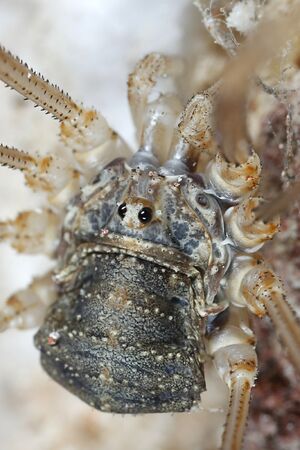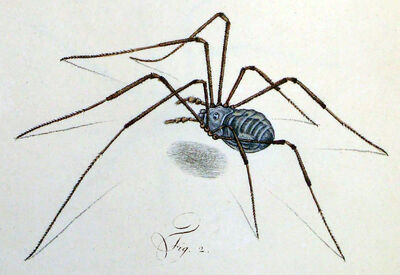| Opilio parietinus | |
|---|---|
 Opilio parietinus, male, from Gulpen-Wittem, Limburg, Netherlands. Photo [4] from flickr, Copyright © Jan van Duinen [5] (used with permission). | |
|
Suborder |
|
|
Superfamily |
|
|
Family |
|
|
Subfamily |
|
|
Genus |
|
Opilio parietinus (De Geer, 1778) is a Holarctic synanthropic species of Opilio.
Abbreviated logonymy[]
(From WCO project): [6]
- Phalangium parietinum De Geer 1778[1]: 166, pl. 10, figs 1–11 [French vernacular “faucheur des murailles”].
—Opilio parietinus: Herbst 1798: 12, 17, pl. I, figs 1–2.
- Opilio longipes Herbst 1798: 22, pl. II, fig. 2 [junior subjective synonym of Phalangium parietinum De Geer, 1778 by Meade (1855: 403); synonymy reaffirmed by Simon (1879b: 211)].
- Phalangium cinereum Wood 1868: 25, figs 5a–c [junior subjective synonym of Phalangium parietinum De Geer, 1778 by Roewer (1911e)].
- Mitopus californicus Banks 1895b: 66; [junior subjective synonym of Phalangium morio Fabricius, 1779 by Roewer (1912e: 45); junior subjective synonym of Phalangium parietinum De Geer, 1778 by Cokendolpher & Holmberg (2018)].
Type data[]
Phalangium parietinum: Type(s) (whereabouts unknown), from locality not mentioned, presumably SWEDEN.
Phalangium cinereum: ♂ ♀ syntypes (whereabouts unknown), from USA, New York, Elizabethtown.
Mitopus californicus: Type(s) (Mus. New York) USA, California, Los Angeles.
Distribution[]
Holarctic synanthropic. “Mitteleuropa, Kleinasien, Sibirien, Turkestan, Mittelmeerländer, Nord-Amerika, Island etc. etc.” [Roewer 1911e]. “All parts of Europe, from Iceland, Siberia, Turkestan, Asia Minor, Canary Islands and North America.” [Spoek 1963]. “Iran, Georgia, ?Afghanistan; introduced to all European countries, Kazakhstan, W Siberia, North America and Tasmania.” [Staręga 2003].
Taxonomy[]
Early depictions[]
Johann Friedrich Wilhelm Herbst (1798)[]

Opilio parietinus (De Geer, 1778) female from Herbst (1798) [2].
Opilio parietinus: Herbst 1798: 12, 17, pl. I, figs 1–2.
The German author loathed the name Phalangium, so he proposed the replacement Opilio (only much later they were regarded as different genera). He even considered Phalangium opilio Linnaeus 1758 to be a synonym of Phalangium parietinum De Geer 1778, only with inverted precedence. He criticized the previous authors for giving only squalid information (which was by the way the reason he did not recognize the difference between both species), mentioned the huge variation in color patterns (some of which was caused by his dealing with two species here) and provided a redescription of the animal we today know as O. parietinus.
"Ob obige Schriftsteller insgesammt diese bestimmte Art beschrieben haben, ist wohl unmöglich auszumachen, weil ihre Beschreibungen zu wenig genau find; ich führe sie also auch mehr nur as solche an, die der ganzen Gattung erwähnen. Es hält überhaupt sehr schwer, sichere specifische Kennzeichenen anzugeben, da fast kein einziges Individuum mit dem andern genau übereinstimmt, und auch nach den verschiedenen Stufen des Alters und der Häutungen die Farben und Zeichnungen ganz verschieden seyn können." (Herbst, 1798: 12-13).
Taxonomic reference[]
Martens 1978[3]: 240, figs 423–428, 435.
Additional images - Gallery[]
References[]
- ↑ De Geer, C. (1778) Des Faucheurs (pp 163–175, pl. 10). In: Mémoires pour servir à l'histoire des insectes. Tome 7. Pierre Hesselberg, Stockholm, xii + 950 pp., 49 pl.[3]
- ↑ Herbst, J.F.W. (1798) Naturgeschichte der Insecten-Gattung Opilio. In: Natursystem der ungeflügelten Insekten, vol. 2 [of 4]. Gottlieb August Lange, Berlin, iv + 26 pp., 5 pls.
- ↑ Martens, J. (1978b) Spinnentiere, Arachnida: Weberknechte, Opiliones. Die Tierwelt Deutschlands. Vol. 64. G. Fischer Verlag, Jena, 464 pp.
| Eupnoi Classification |
|---|
| Incertae sedis | ||
|---|---|---|
| Not assigned to any family | †Brigantibunum | †Daohugopilio | †Macrogyion | Hesperopilio | |
| Superfamily Caddoidea | ||
|---|---|---|
| Family Caddidae | Caddo | |
![Opilio parietinus female from Gulpen-Wittem, Limburg, Netherlands, by Jan van Duinen.jpg (402 KB) Opilio parietinus female from Gulpen-Wittem, Limburg, Netherlands. Photo [1] Copyright © Jan van Duinen [2] (used with permission).](https://static.wikia.nocookie.net/opiliones/images/d/da/Opilio_parietinus_female_from_Gulpen-Wittem%2C_Limburg%2C_Netherlands%2C_by_Jan_van_Duinen.jpg/revision/latest/scale-to-width-down/400?cb=20190511194319)